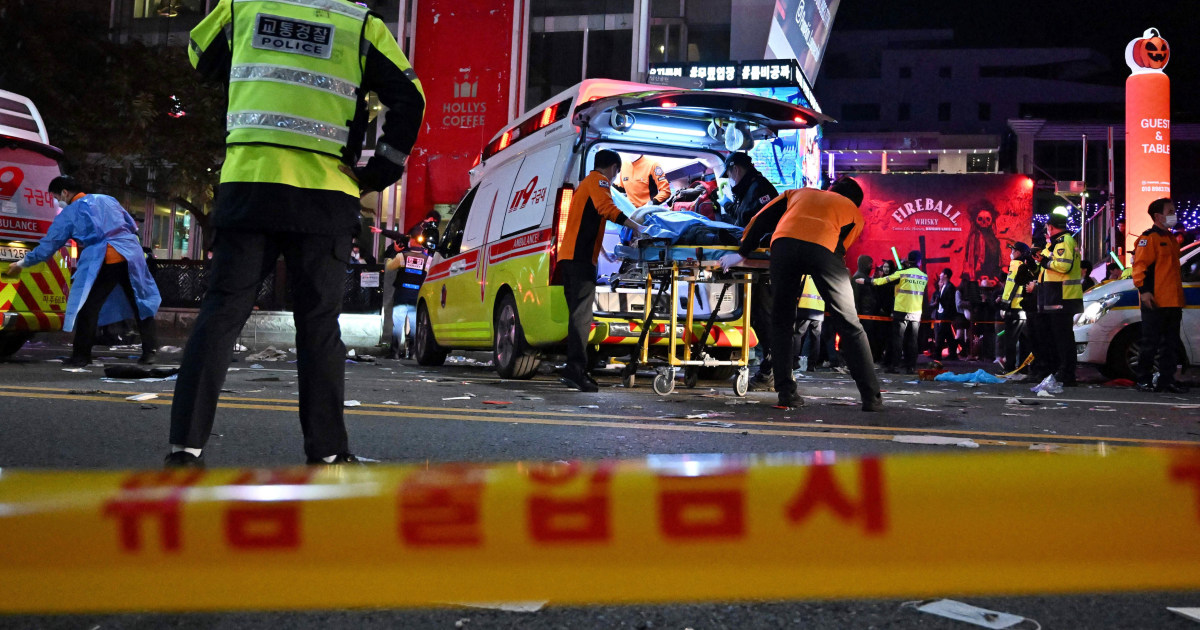SEOUL, South Korea — The first warning came around four hours before the crush turned deadly in Seoul’s Itaewon neighborhood as revelers celebrated Halloween.
“Too many people are going up and down and it’s too scary,” the unidentified caller told police in the South Korean capital as the crowds built up at around 6:30 p.m. local time (4:30 a.m ET) on Saturday. “People aren’t able to come down but [people] are also pushing to go up and I think [they] could get crushed to death.”
It was one of 11 call transcripts released by South Korea‘s National Police Agency on Tuesday, which show callers used the Korean word meaning “crushed to death” at least 13 different times as they asked for help before the tragedy unfolded in a narrow alley that runs between the hotel and a dense row of storefronts. Authorities said 156 people were killed.
Police and government officials have faced pointed questions about why they didn’t employ crowd controls or sufficient personnel in the small nightlife district, despite anticipating a crowd of 100,000.
Seoul Mayor Oh Se-hoon wept and briefly halted a news conference Tuesday as he talked about the parent of a 20-year-old woman who was declared dead earlier in the day. “I am sorry that my apology has come late,” he said.
His comments came less than 24 hours before members of the National Police Agency’s special investigation unit raided police departments in the city as part of its investigation into whether bureaucratic ineptitude contributed to the situation.
“At about five people per square meter, any kind of crowd movement can create a crush,” said John Drury, professor of crowd psychology at the University of Sussex in the United Kingdom. “It actually collapses the chest, causes asphyxiation and people can die standing up.”
Based on video he had seen, he said that the situation in Seoul was “a recipe for disaster” because too many people were in the same place making it hard for them to leave, and there was “no single flow of movement because people were trying to do different things.”
His assessment appears to be corroborated by Lee Kyung-min, 29, who said she had dressed up and had her makeup done for a rare opportunity to have fun following the easing of Covid restrictions in recent months and to shake off stress from a demanding new job.
At first, she said she was curious about the large number of people, so she joined the throng with her friend but “suddenly we felt the crowd surge very quickly and I felt stuffy.”
“Then I started to smell a strange stench that often comes with too many people around,” she said, adding that they turned away “because we felt the crowd to be dangerous.”
Stewards and barricades could have been set up to regulate the inflow of the crowd, said Keith Still, a professor of crowd science at the University of Suffolk in the United Kingdom. “Once you understand the risk, then put the mitigation measures in place to regulate the number of people that flow into that area,” he said.
As Saturday’s festivities had no central organizer, unlike political events or pop concerts, government authorities were not legally required to establish or enforce safety protocols. Chief Kim Gwang-ho from the Seoul Metropolitan Police Agency said at a news conference Monday that police had no legal guidance on how to respond.
He said 137 officers had been sent to the neighborhood, more than in the years before the pandemic, although they had been tasked with preventing crime rather than crowd control.
He added that police had anticipated big crowds but “didn’t expect large-scale casualties.”

For Milad Haghani, a senior lecturer who focuses on transport and safety research at the University of New South Wales in Australia, police should have been better prepared on Halloween, which is not a traditional holiday in South Korea, but is still a major attraction for young people and widely promoted in bars and clubs.
“You can go to the past and have a rough idea of how many people have shown up and also take into account the fact that this is an event after social distancing measures have been lifted,” he said.
He added that “the routes for paramedics to be able to navigate through the crowd were not predicted, and because the area was so restricted, that wouldn’t have given any access to the heart of the crowd.”
With emergency personnel effectively blocked from tending the unconscious bodies, partygoers like Sophia Akhiyat, a doctor visiting from Florida, said she had to step in to perform CPR. “It was just the sheer amount of victims on the floor,” she said.

Even if planning was poor, Haghani said that artificial intelligence-based crowd management tools are available that enable operators to rapidly deploy emergency measures.
“Using real-time CCTV footage, you can determine the mood of the crowd using facial recognition tools and tell when it is getting uncomfortable,” he said. “If somebody has the expertise to interpret these signals, you can then stop the inflow.”
National Police Chief Yoon Hee Keun acknowledged Monday that initial investigations found that police officers failed to effectively handle calls notifying authorities about the potential danger of the crowd gathering in Itaewon.
Yoon said police have launched an internal probe into the officers’ handling of the emergency calls and other issues, including the on-the-spot response to the crowd surge in Itaewon that night.
Among the calls investigated will be one that came in around four minutes before people began to fall over each at around 10:15 p.m.
Noting that screams were heard over the phone, the transcript of the call says: “We are going to be crushed to death here. It’s crazy.”
Stella Kim reported from Seoul, and Mithil Aggarwal from Hong Kong.
Share your story or advertise with us: Whatsapp: +2347068606071 Email: info@newspotng.com













